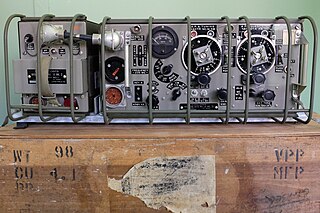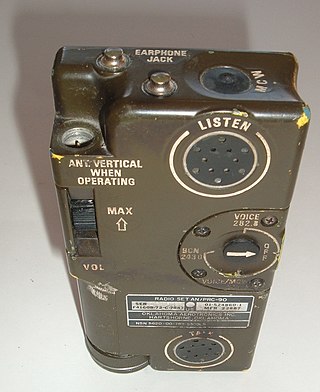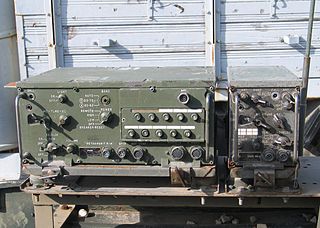
A walkie-talkie, more formally known as a handheld transceiver (HT), is a hand-held, portable, two-way radio transceiver. Its development during the Second World War has been variously credited to Donald Hings, radio engineer Alfred J. Gross, Henryk Magnuski and engineering teams at Motorola. First used for infantry, similar designs were created for field artillery and tank units, and after the war, walkie-talkies spread to public safety and eventually commercial and jobsite work.
The R. L. Drake Company is a manufacturer of electronic communications equipment located in Springboro, Ohio. It is also known for its line of equipment for amateur radio and shortwave listening, built in the 1950s through the 1980s. The company operates as a separate entity owned by Blonder Tongue Laboratories, Inc.

The AN/ARC-5 Command Radio Set is a series of radio receivers, transmitters, and accessories carried aboard U.S. Navy aircraft during World War II and for some years afterward. It is described as "a complete multi-channel radio transmitting and receiving set providing communication and navigation facilities for aircraft. The LF-MF-HF components are designed to transmit and receive voice, tone-modulated, and continuous wave (cw) signals." Its flexible design provided AM radiotelephone voice communication and Modulated continuous wave (MCW) and Continuous wave (CW) Morse code modes, all of which are typical capabilities in other Navy aircraft communication sets of the period. It was an improvement of the Navy's ARA/ATA command set. Similar units designated SCR-274-N were used in U.S. Army aircraft. The Army set is based on the ARA/ATA, not the later AN/ARC-5. The ARA/ATA and SCR-274-N series are informally referred to as "ARC-5", despite small differences that render all three series incompatible. Like the AN/ARC-5, the ARA/ATA and SCR-274-N had AM voice communication and two-way MCW and CW Morse code capability.

Yaesu FT-101 is a model line of modular amateur radio transceivers, built by the Yaesu Corporation in Japan during the 1970s and 1980s. FT-101 is a set that combines a solid state transmitter, receiver and a tube final amplifier. Its solid state features offer high-performance, low-current characteristics and its tube amplifier provides an almost mismatch-resistant transmitter and tuner stage. FT-101s were made with plug-in circuit boards that could be sent to the dealer or factory for replacement or repair. Until then, modular design was unprecedented in the amateur community. This also explains the fact why so many FT-101s are still in use today. The rig was sold worldwide as Yaesu FT-101 and in Europe as Yaesu FT-101 and as Sommerkamp FT-277. Because of its reliability it earned its nickname "the workhorse".

Clansman is the name of a combat net radio system (CNR) used by the British Army from 1976 to 2010.

Larkspur was the retrospectively adopted name of a tactical radio system used by the British Army. Its development started in the late 1940s with the first equipment being issued in the mid-1950s. It remained in service until replaced by Clansman in the late-1970s although some elements of Larkspur were still in service well into the 1980s. It was widely exported to British Commonwealth armies and other friendly nations.

The AN/ART-13 was a radio transmitter manufactured by Collins Radio that found widespread use during and after World War II in military aircraft.

The AN/PRC-150(C) Falcon II Manpack Radio, is a tactical HF-SSB/ VHF-FM manpack radio manufactured by Harris Corporation. It holds an NSA certification for Type 1 encryption. The PRC-150 is the manpack HF radio for the Harris Falcon II family of radios, introduced in the early 2000's.

The Wireless Set No. 19 was a Second World War mobile radio transceiver designed for use by armoured troops of the British Army. First introduced in 1940, the No. 19 began to replace the pre-war Wireless Set No. 11. Two modified versions were introduced, Mk. II in 1941 and Mk. III in 1942. An improved version from Canada was introduced in 1942 for use primarily with other forces. In British service, the No. 19 was replaced in the post-war era by the Larkspur radio system. Canadian-built No. 19s saw continued service for many years with a variety of users.

The Paraset was a small, low-power, thermionic valve, CW-only radio transmitter-receiver supplied to the resistance groups in France, Belgium and the Netherlands during World War II.

Survival radios are carried by pilots and search and rescue teams to facilitate rescue in an emergency. They are generally designed to transmit on international distress frequencies. Maritime systems have been standardized under the Global Maritime Distress Safety System. Civil and military organisation's utilized different frequencies to communicate and no infringement on either sector would take place. For emergencies involving civilian aircraft, the radio frequency used is VHF 121.5 MHz and for military aircraft incidents, the frequency used is UHF 243 MHz.

The SCR-300 was a portable radio transceiver used by US Signal Corps in World War II. This backpack-mounted unit was the first radio to be nicknamed a "walkie talkie".

AN/PRC 113 Radio Set is a manpack, portable VHF and UHF AM combat radio transceiver manufactured by Magnavox America. In the Joint Electronics Type Designation System (JETDS), AN/PRC translates to "Army/Navy, Portable, Radio, Communication.
During World War II, the German Army relied on an diverse array of communications to maintain contact with its mobile forces and in particular with its armoured forces. Most of this equipment received the generic prefix FuG for Funkgerät, meaning "radio device". Occasionally the shorted Fu designation were used and there were exceptions to both these systems. Number ranges were not unique across the services so sometimes different equipment used by different services had the same FuG prefix. This article is a list and a description of the radio equipment.

The AN/VRC-12 is the lowest-numbered element of a family of vehicular VHF-FM synthesized vehicular radio communications systems developed by Avco Corporation and introduced around 1963 and used extensively by the U.S. military during the Vietnam War and for many years after. It replaced the earlier AN/GRC-3 through 8 series and was, in turn, replaced by the Single Channel Ground and Airborne Radio System (SINCGARS) in the early 1990s. The sets were manufactured by its original developer, Avco based in Cincinnati, Oh, and Magnavox, Ft. Wayne, Indiana Texas Instruments was one of the principal bidders that proposed improved, ultra-reliable (failure-free) variant of VRC-12 in the late 1960s, but failed to win the competition. RCA bid for ultra-reliable variant in the early 1970s was also unsuccessful.
The AN/PRC-10 is an American VHF portable radio transceiver, introduced in 1951 as a replacement for the wartime SCR-300 set. The AN/PRC-8 and AN/PRC-9 sets are basically the same but cover lower frequency bands. It remained in service with the American military until the mid 1960s when it was replaced by the transistorized AN/PRC-25 set.

HRM-7000 is a German military shortwave-transceiver of Elbit Systems, formerly Telefunken Racom. It is one of the Communication systems of the German Bundeswehr.
The ICOM IC-7100 is a multimode HF/VHF/UHF mobile amateur radio transceiver. The IC-7100 has support for a wide variety of commonly used amateur radio modes including ICOMs proprietary digital voice mode DSTAR. Additionally the radio offers 100 watts on HF, 50 watts on VHF, and 35 watts on UHF. The IC-7100 is unique in that it has a large detachable control head with a slanted display so the transmitter can be installed elsewhere in a vehicle or home. The receiver used in the IC-7100 is a triple conversion superheterodyne and has excellent DSP and audio filters. The IC-7100 allows for connection to a computer over USB which enables the radio to be used for popular digital modes such as FT8, Winlink, and Packet Operation. Locations of nearby repeaters and sending APRS locations can be done with an optional GPS receiver attachment. Notable features that the IC-7100 lacks is an internal antenna tuner.













